Risk-Based Regulation and Compliance: A Business Report Analysis
VerifiedAdded on 2020/11/12
|9
|2765
|70
Report
AI Summary
This report provides a comprehensive overview of compliance in a business context, emphasizing the importance of risk-based regulation and the role of compliance professionals. It defines compliance, highlights the significance of compliance policies in the workplace, and outlines the powers of regulators and their impact on firms. The report analyzes the aims and objectives of selected business principles, particularly focusing on activities within a regulated firm and customer relations. It also examines the challenges faced by regulators in the food sector, suggesting effective support strategies. Furthermore, the report delves into the main activities of the compliance function within a regulated firm and includes a scenario-based analysis of a recruitment process, specifically a job description for a Head of Compliance. The content draws on documentation from the UK food sector regulator, offering insights into maintaining standards and addressing industry-specific challenges.
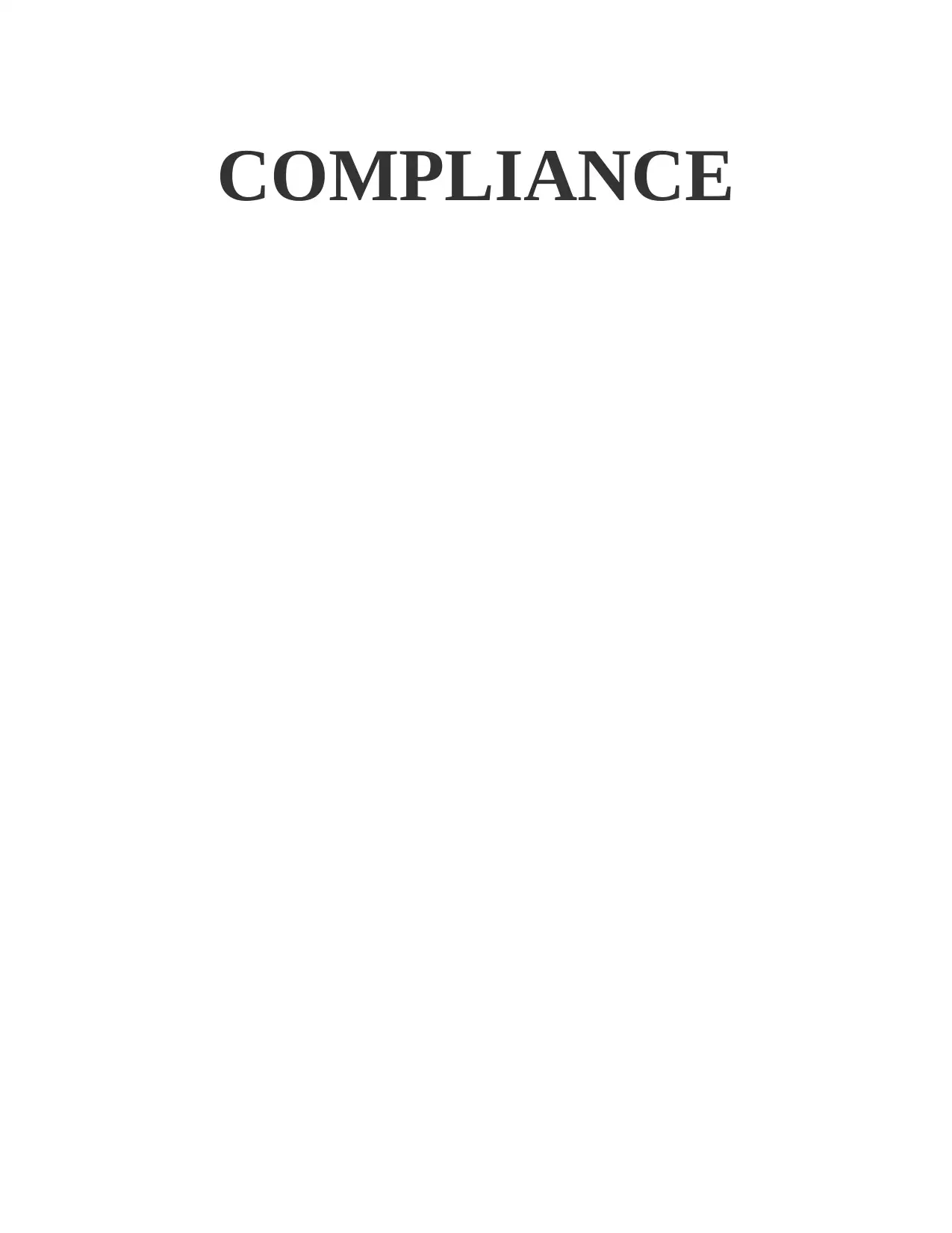
COMPLIANCE
Paraphrase This Document
Need a fresh take? Get an instant paraphrase of this document with our AI Paraphraser
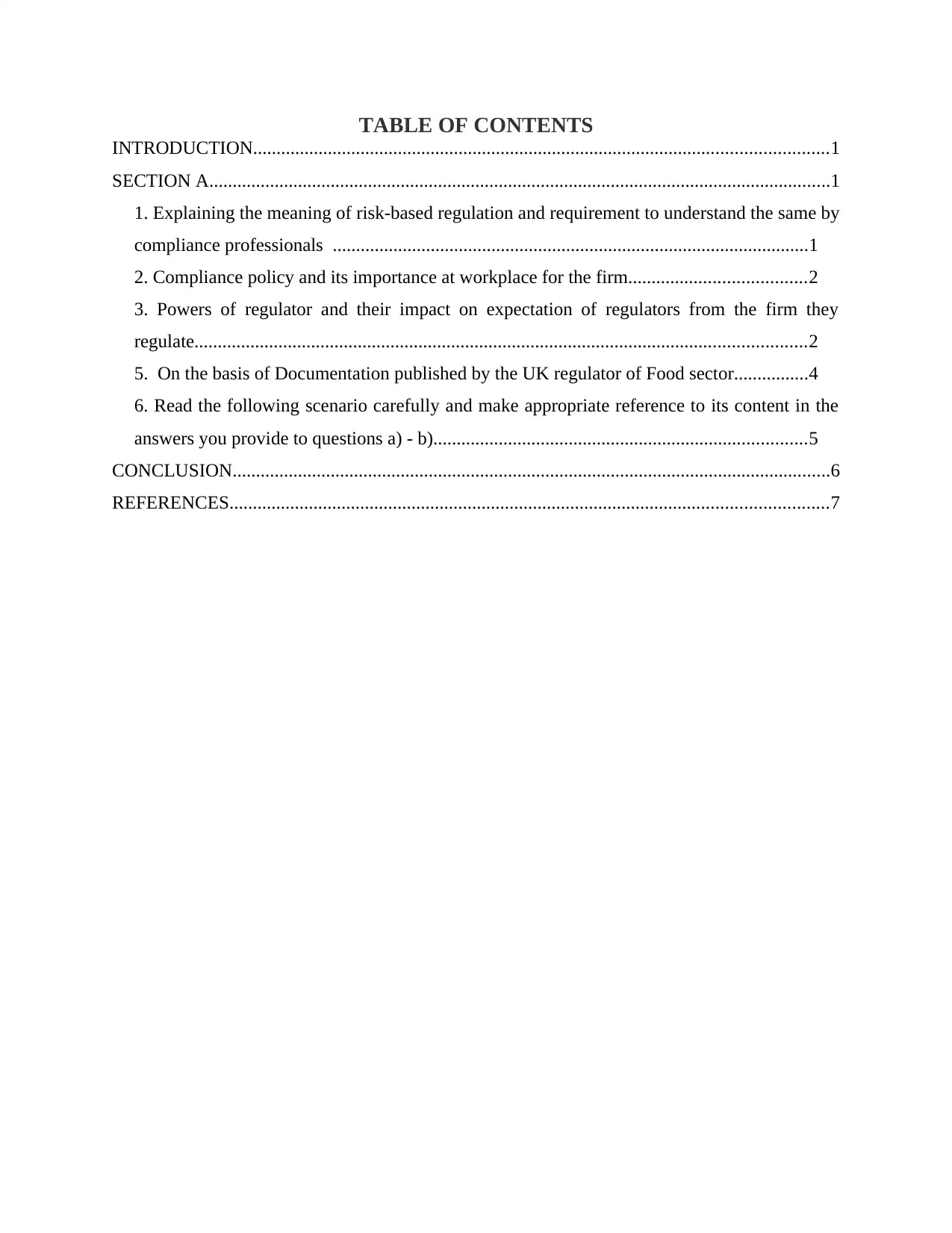
TABLE OF CONTENTS
INTRODUCTION...........................................................................................................................1
SECTION A.....................................................................................................................................1
1. Explaining the meaning of risk-based regulation and requirement to understand the same by
compliance professionals ......................................................................................................1
2. Compliance policy and its importance at workplace for the firm......................................2
3. Powers of regulator and their impact on expectation of regulators from the firm they
regulate...................................................................................................................................2
5. On the basis of Documentation published by the UK regulator of Food sector................4
6. Read the following scenario carefully and make appropriate reference to its content in the
answers you provide to questions a) - b)................................................................................5
CONCLUSION................................................................................................................................6
REFERENCES................................................................................................................................7
INTRODUCTION...........................................................................................................................1
SECTION A.....................................................................................................................................1
1. Explaining the meaning of risk-based regulation and requirement to understand the same by
compliance professionals ......................................................................................................1
2. Compliance policy and its importance at workplace for the firm......................................2
3. Powers of regulator and their impact on expectation of regulators from the firm they
regulate...................................................................................................................................2
5. On the basis of Documentation published by the UK regulator of Food sector................4
6. Read the following scenario carefully and make appropriate reference to its content in the
answers you provide to questions a) - b)................................................................................5
CONCLUSION................................................................................................................................6
REFERENCES................................................................................................................................7
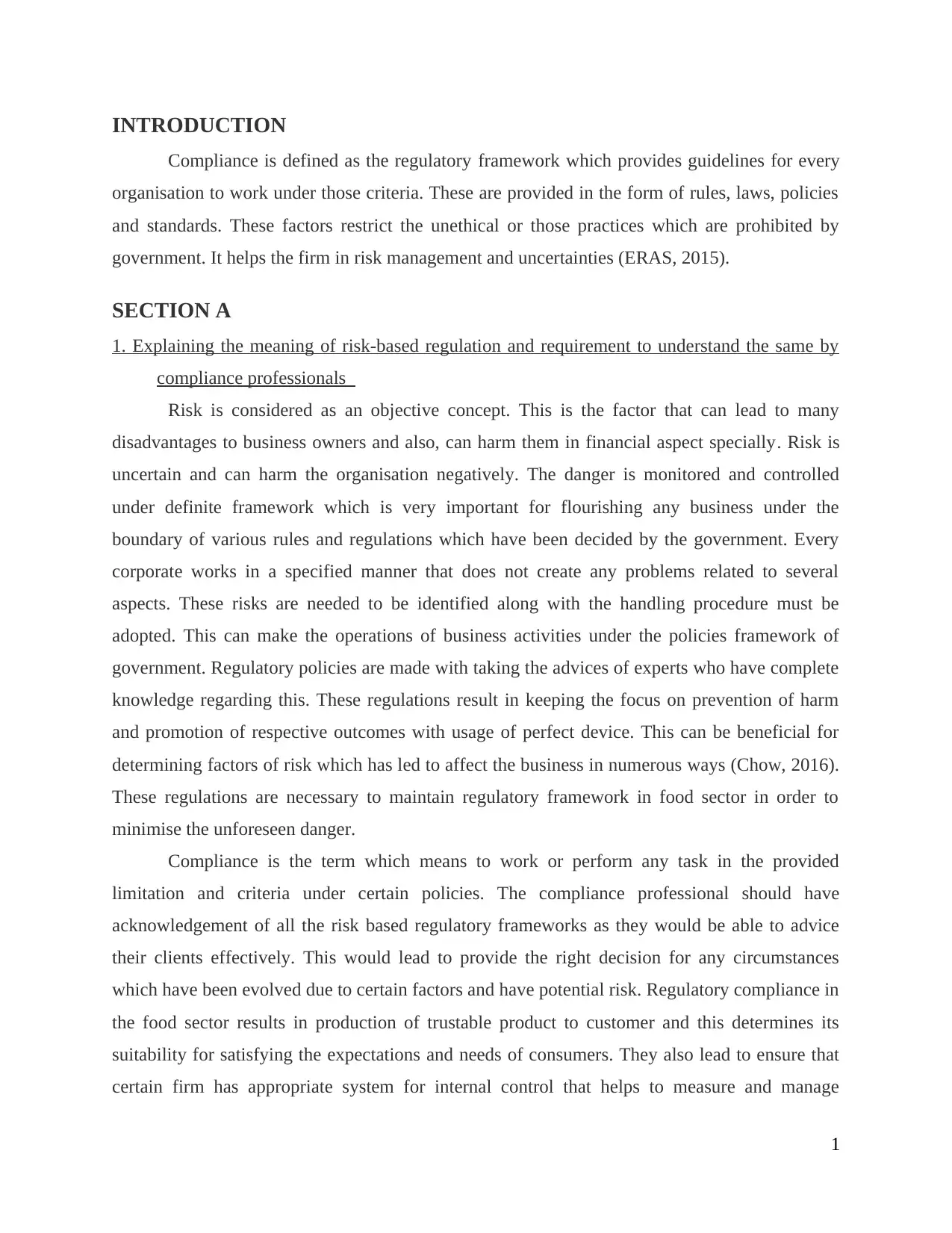
INTRODUCTION
Compliance is defined as the regulatory framework which provides guidelines for every
organisation to work under those criteria. These are provided in the form of rules, laws, policies
and standards. These factors restrict the unethical or those practices which are prohibited by
government. It helps the firm in risk management and uncertainties (ERAS, 2015).
SECTION A
1. Explaining the meaning of risk-based regulation and requirement to understand the same by
compliance professionals
Risk is considered as an objective concept. This is the factor that can lead to many
disadvantages to business owners and also, can harm them in financial aspect specially. Risk is
uncertain and can harm the organisation negatively. The danger is monitored and controlled
under definite framework which is very important for flourishing any business under the
boundary of various rules and regulations which have been decided by the government. Every
corporate works in a specified manner that does not create any problems related to several
aspects. These risks are needed to be identified along with the handling procedure must be
adopted. This can make the operations of business activities under the policies framework of
government. Regulatory policies are made with taking the advices of experts who have complete
knowledge regarding this. These regulations result in keeping the focus on prevention of harm
and promotion of respective outcomes with usage of perfect device. This can be beneficial for
determining factors of risk which has led to affect the business in numerous ways (Chow, 2016).
These regulations are necessary to maintain regulatory framework in food sector in order to
minimise the unforeseen danger.
Compliance is the term which means to work or perform any task in the provided
limitation and criteria under certain policies. The compliance professional should have
acknowledgement of all the risk based regulatory frameworks as they would be able to advice
their clients effectively. This would lead to provide the right decision for any circumstances
which have been evolved due to certain factors and have potential risk. Regulatory compliance in
the food sector results in production of trustable product to customer and this determines its
suitability for satisfying the expectations and needs of consumers. They also lead to ensure that
certain firm has appropriate system for internal control that helps to measure and manage
1
Compliance is defined as the regulatory framework which provides guidelines for every
organisation to work under those criteria. These are provided in the form of rules, laws, policies
and standards. These factors restrict the unethical or those practices which are prohibited by
government. It helps the firm in risk management and uncertainties (ERAS, 2015).
SECTION A
1. Explaining the meaning of risk-based regulation and requirement to understand the same by
compliance professionals
Risk is considered as an objective concept. This is the factor that can lead to many
disadvantages to business owners and also, can harm them in financial aspect specially. Risk is
uncertain and can harm the organisation negatively. The danger is monitored and controlled
under definite framework which is very important for flourishing any business under the
boundary of various rules and regulations which have been decided by the government. Every
corporate works in a specified manner that does not create any problems related to several
aspects. These risks are needed to be identified along with the handling procedure must be
adopted. This can make the operations of business activities under the policies framework of
government. Regulatory policies are made with taking the advices of experts who have complete
knowledge regarding this. These regulations result in keeping the focus on prevention of harm
and promotion of respective outcomes with usage of perfect device. This can be beneficial for
determining factors of risk which has led to affect the business in numerous ways (Chow, 2016).
These regulations are necessary to maintain regulatory framework in food sector in order to
minimise the unforeseen danger.
Compliance is the term which means to work or perform any task in the provided
limitation and criteria under certain policies. The compliance professional should have
acknowledgement of all the risk based regulatory frameworks as they would be able to advice
their clients effectively. This would lead to provide the right decision for any circumstances
which have been evolved due to certain factors and have potential risk. Regulatory compliance in
the food sector results in production of trustable product to customer and this determines its
suitability for satisfying the expectations and needs of consumers. They also lead to ensure that
certain firm has appropriate system for internal control that helps to measure and manage
1
⊘ This is a preview!⊘
Do you want full access?
Subscribe today to unlock all pages.

Trusted by 1+ million students worldwide

possible risks which they face while completing the tasks for accomplishing business goals
(Kelman, 2017).
2. Compliance policy and its importance at workplace for the firm
Compliance policies are those which lead to determine for conforming a particular rule
which includes certain specifications, standards, policies or law. It determines aspect related to
the belief of a country for providing guidance to regulate and control working of task. It provides
description related to the goals which organisation wants to accomplish for ensuring that they are
completely aware and work accordingly as per given policies, laws and other regulations. Also,
with the increase in regulations, needs have increased for more transparency in operations.
Therefore, due to this, every organisation in the food sector is leading to adopt respective
principles and controlling measures which are related with compliance policies. These policies
lead to provide surety which are related to governance and can be achieved without putting an
extra effort for performing the activities from resources.
Some of the regulations have been derived from European Union Legislation. It helps to
set the prescribed standards of good practices which are involved in expansion of leadership and
other factors such as remuneration, effectiveness, relations with shareholders and accountability
(Gass and Seiter, 2015). It has a major importance in providing assistance for regulating the firm
which is data retention as it is known to be the part of regulatory compliance. It leads to provide
various rules and principles which can determine how to conduct the activities for delivery of
services. It leads to authorise all the services which are provided to visitors. It provides the
supervision for compliance along with certain rules which can be approached by any
methodology. It provides aid for cooperation and exchange of information among all regulators.
3. Powers of regulator and their impact on expectation of regulators from the firm they regulate
Regulator is that individual who is responsible for measuring, controlling and providing
suggestion for compliance policies in an organisation. The person is required to monitor all the
tasks which are performed under specified restrictions and criteria defined for effective
performance and delivery of services to the consumers. They have many powers as it have the
authority to govern structure of an organisation. It has the power for inspecting and requesting
information related to many functionalities. It prescribes the orders for compelling a business to
comply with. They have the power of removing director and auditors who are not performing
2
(Kelman, 2017).
2. Compliance policy and its importance at workplace for the firm
Compliance policies are those which lead to determine for conforming a particular rule
which includes certain specifications, standards, policies or law. It determines aspect related to
the belief of a country for providing guidance to regulate and control working of task. It provides
description related to the goals which organisation wants to accomplish for ensuring that they are
completely aware and work accordingly as per given policies, laws and other regulations. Also,
with the increase in regulations, needs have increased for more transparency in operations.
Therefore, due to this, every organisation in the food sector is leading to adopt respective
principles and controlling measures which are related with compliance policies. These policies
lead to provide surety which are related to governance and can be achieved without putting an
extra effort for performing the activities from resources.
Some of the regulations have been derived from European Union Legislation. It helps to
set the prescribed standards of good practices which are involved in expansion of leadership and
other factors such as remuneration, effectiveness, relations with shareholders and accountability
(Gass and Seiter, 2015). It has a major importance in providing assistance for regulating the firm
which is data retention as it is known to be the part of regulatory compliance. It leads to provide
various rules and principles which can determine how to conduct the activities for delivery of
services. It leads to authorise all the services which are provided to visitors. It provides the
supervision for compliance along with certain rules which can be approached by any
methodology. It provides aid for cooperation and exchange of information among all regulators.
3. Powers of regulator and their impact on expectation of regulators from the firm they regulate
Regulator is that individual who is responsible for measuring, controlling and providing
suggestion for compliance policies in an organisation. The person is required to monitor all the
tasks which are performed under specified restrictions and criteria defined for effective
performance and delivery of services to the consumers. They have many powers as it have the
authority to govern structure of an organisation. It has the power for inspecting and requesting
information related to many functionalities. It prescribes the orders for compelling a business to
comply with. They have the power of removing director and auditors who are not performing
2
Paraphrase This Document
Need a fresh take? Get an instant paraphrase of this document with our AI Paraphraser
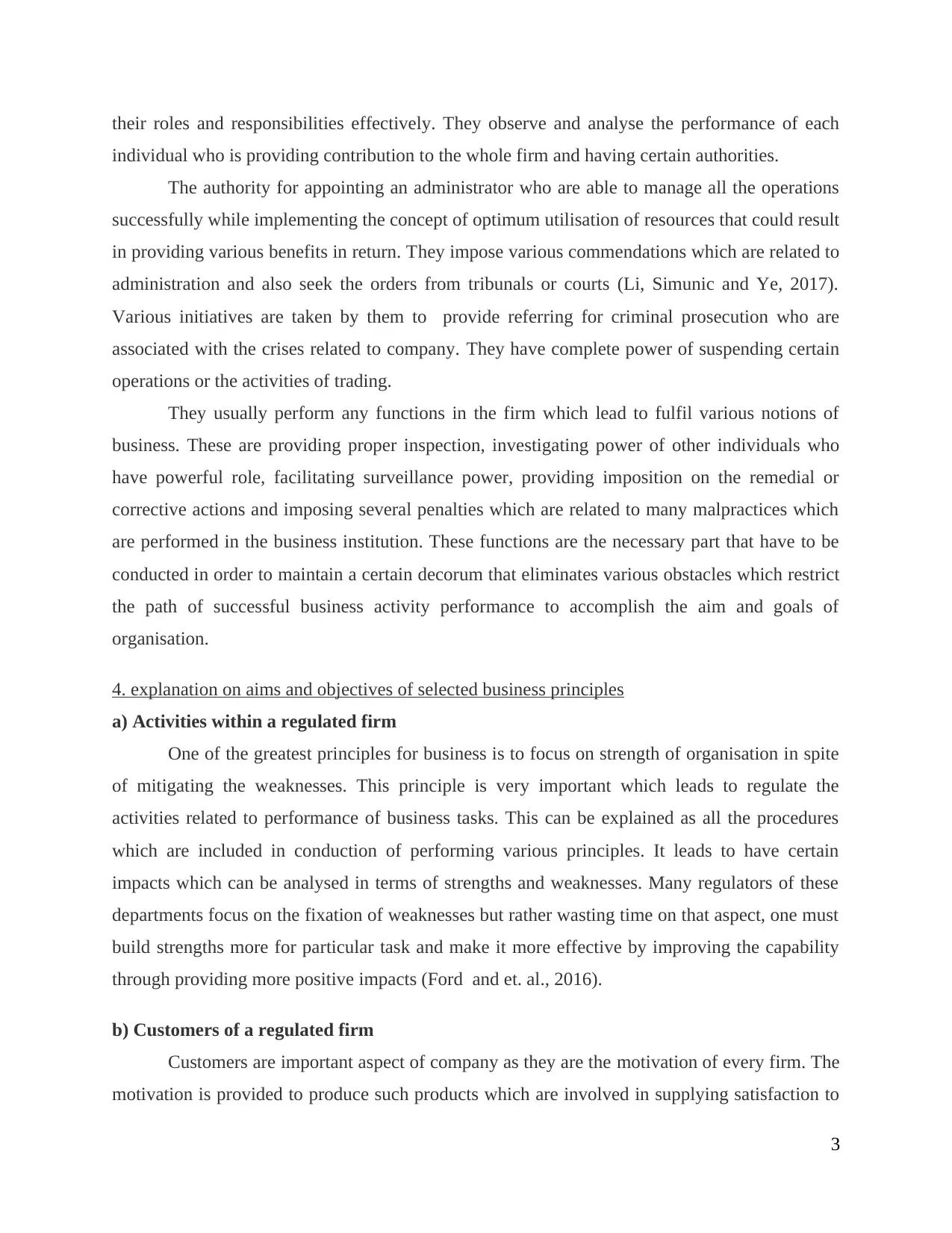
their roles and responsibilities effectively. They observe and analyse the performance of each
individual who is providing contribution to the whole firm and having certain authorities.
The authority for appointing an administrator who are able to manage all the operations
successfully while implementing the concept of optimum utilisation of resources that could result
in providing various benefits in return. They impose various commendations which are related to
administration and also seek the orders from tribunals or courts (Li, Simunic and Ye, 2017).
Various initiatives are taken by them to provide referring for criminal prosecution who are
associated with the crises related to company. They have complete power of suspending certain
operations or the activities of trading.
They usually perform any functions in the firm which lead to fulfil various notions of
business. These are providing proper inspection, investigating power of other individuals who
have powerful role, facilitating surveillance power, providing imposition on the remedial or
corrective actions and imposing several penalties which are related to many malpractices which
are performed in the business institution. These functions are the necessary part that have to be
conducted in order to maintain a certain decorum that eliminates various obstacles which restrict
the path of successful business activity performance to accomplish the aim and goals of
organisation.
4. explanation on aims and objectives of selected business principles
a) Activities within a regulated firm
One of the greatest principles for business is to focus on strength of organisation in spite
of mitigating the weaknesses. This principle is very important which leads to regulate the
activities related to performance of business tasks. This can be explained as all the procedures
which are included in conduction of performing various principles. It leads to have certain
impacts which can be analysed in terms of strengths and weaknesses. Many regulators of these
departments focus on the fixation of weaknesses but rather wasting time on that aspect, one must
build strengths more for particular task and make it more effective by improving the capability
through providing more positive impacts (Ford and et. al., 2016).
b) Customers of a regulated firm
Customers are important aspect of company as they are the motivation of every firm. The
motivation is provided to produce such products which are involved in supplying satisfaction to
3
individual who is providing contribution to the whole firm and having certain authorities.
The authority for appointing an administrator who are able to manage all the operations
successfully while implementing the concept of optimum utilisation of resources that could result
in providing various benefits in return. They impose various commendations which are related to
administration and also seek the orders from tribunals or courts (Li, Simunic and Ye, 2017).
Various initiatives are taken by them to provide referring for criminal prosecution who are
associated with the crises related to company. They have complete power of suspending certain
operations or the activities of trading.
They usually perform any functions in the firm which lead to fulfil various notions of
business. These are providing proper inspection, investigating power of other individuals who
have powerful role, facilitating surveillance power, providing imposition on the remedial or
corrective actions and imposing several penalties which are related to many malpractices which
are performed in the business institution. These functions are the necessary part that have to be
conducted in order to maintain a certain decorum that eliminates various obstacles which restrict
the path of successful business activity performance to accomplish the aim and goals of
organisation.
4. explanation on aims and objectives of selected business principles
a) Activities within a regulated firm
One of the greatest principles for business is to focus on strength of organisation in spite
of mitigating the weaknesses. This principle is very important which leads to regulate the
activities related to performance of business tasks. This can be explained as all the procedures
which are included in conduction of performing various principles. It leads to have certain
impacts which can be analysed in terms of strengths and weaknesses. Many regulators of these
departments focus on the fixation of weaknesses but rather wasting time on that aspect, one must
build strengths more for particular task and make it more effective by improving the capability
through providing more positive impacts (Ford and et. al., 2016).
b) Customers of a regulated firm
Customers are important aspect of company as they are the motivation of every firm. The
motivation is provided to produce such products which are involved in supplying satisfaction to
3
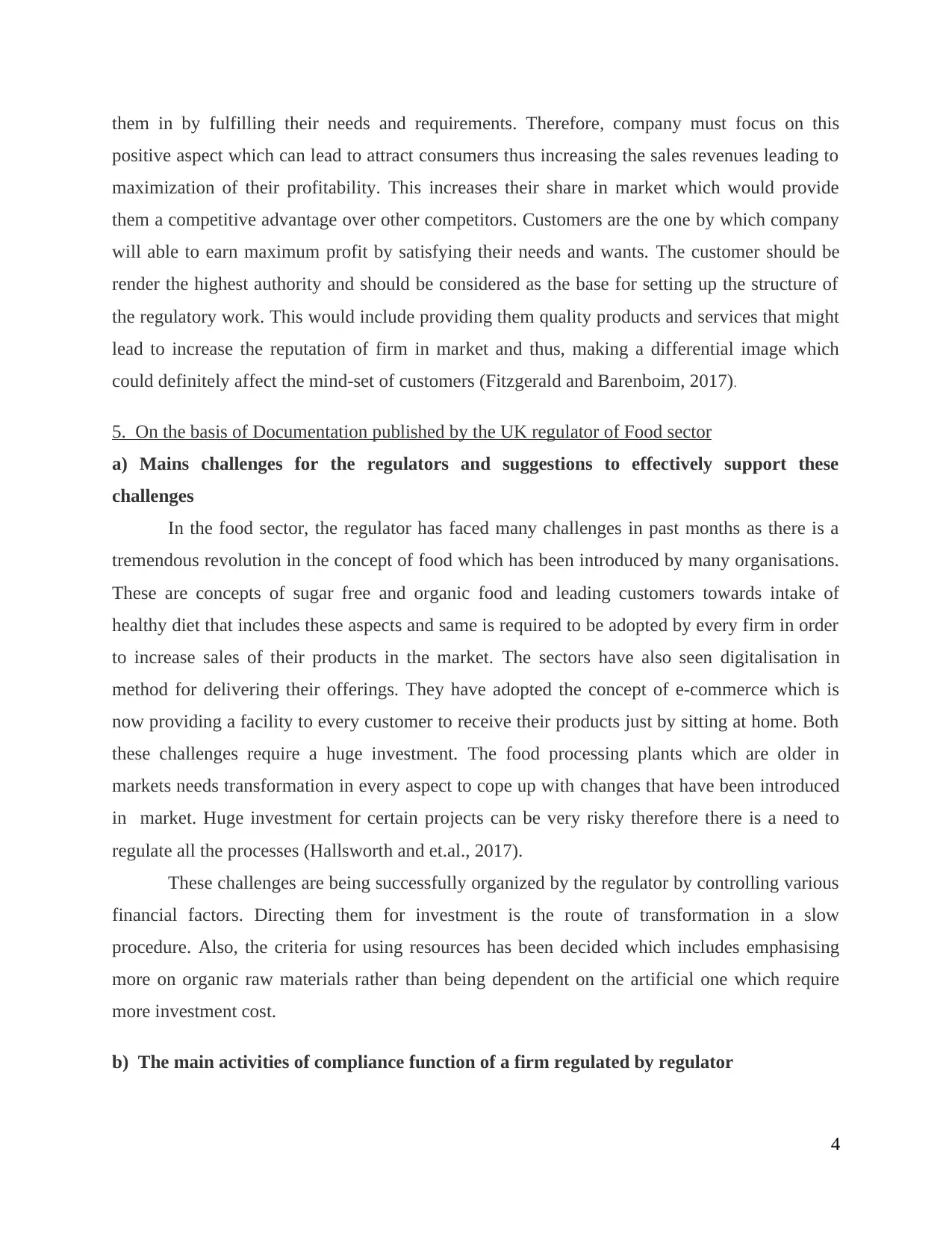
them in by fulfilling their needs and requirements. Therefore, company must focus on this
positive aspect which can lead to attract consumers thus increasing the sales revenues leading to
maximization of their profitability. This increases their share in market which would provide
them a competitive advantage over other competitors. Customers are the one by which company
will able to earn maximum profit by satisfying their needs and wants. The customer should be
render the highest authority and should be considered as the base for setting up the structure of
the regulatory work. This would include providing them quality products and services that might
lead to increase the reputation of firm in market and thus, making a differential image which
could definitely affect the mind-set of customers (Fitzgerald and Barenboim, 2017).
5. On the basis of Documentation published by the UK regulator of Food sector
a) Mains challenges for the regulators and suggestions to effectively support these
challenges
In the food sector, the regulator has faced many challenges in past months as there is a
tremendous revolution in the concept of food which has been introduced by many organisations.
These are concepts of sugar free and organic food and leading customers towards intake of
healthy diet that includes these aspects and same is required to be adopted by every firm in order
to increase sales of their products in the market. The sectors have also seen digitalisation in
method for delivering their offerings. They have adopted the concept of e-commerce which is
now providing a facility to every customer to receive their products just by sitting at home. Both
these challenges require a huge investment. The food processing plants which are older in
markets needs transformation in every aspect to cope up with changes that have been introduced
in market. Huge investment for certain projects can be very risky therefore there is a need to
regulate all the processes (Hallsworth and et.al., 2017).
These challenges are being successfully organized by the regulator by controlling various
financial factors. Directing them for investment is the route of transformation in a slow
procedure. Also, the criteria for using resources has been decided which includes emphasising
more on organic raw materials rather than being dependent on the artificial one which require
more investment cost.
b) The main activities of compliance function of a firm regulated by regulator
4
positive aspect which can lead to attract consumers thus increasing the sales revenues leading to
maximization of their profitability. This increases their share in market which would provide
them a competitive advantage over other competitors. Customers are the one by which company
will able to earn maximum profit by satisfying their needs and wants. The customer should be
render the highest authority and should be considered as the base for setting up the structure of
the regulatory work. This would include providing them quality products and services that might
lead to increase the reputation of firm in market and thus, making a differential image which
could definitely affect the mind-set of customers (Fitzgerald and Barenboim, 2017).
5. On the basis of Documentation published by the UK regulator of Food sector
a) Mains challenges for the regulators and suggestions to effectively support these
challenges
In the food sector, the regulator has faced many challenges in past months as there is a
tremendous revolution in the concept of food which has been introduced by many organisations.
These are concepts of sugar free and organic food and leading customers towards intake of
healthy diet that includes these aspects and same is required to be adopted by every firm in order
to increase sales of their products in the market. The sectors have also seen digitalisation in
method for delivering their offerings. They have adopted the concept of e-commerce which is
now providing a facility to every customer to receive their products just by sitting at home. Both
these challenges require a huge investment. The food processing plants which are older in
markets needs transformation in every aspect to cope up with changes that have been introduced
in market. Huge investment for certain projects can be very risky therefore there is a need to
regulate all the processes (Hallsworth and et.al., 2017).
These challenges are being successfully organized by the regulator by controlling various
financial factors. Directing them for investment is the route of transformation in a slow
procedure. Also, the criteria for using resources has been decided which includes emphasising
more on organic raw materials rather than being dependent on the artificial one which require
more investment cost.
b) The main activities of compliance function of a firm regulated by regulator
4
⊘ This is a preview!⊘
Do you want full access?
Subscribe today to unlock all pages.

Trusted by 1+ million students worldwide
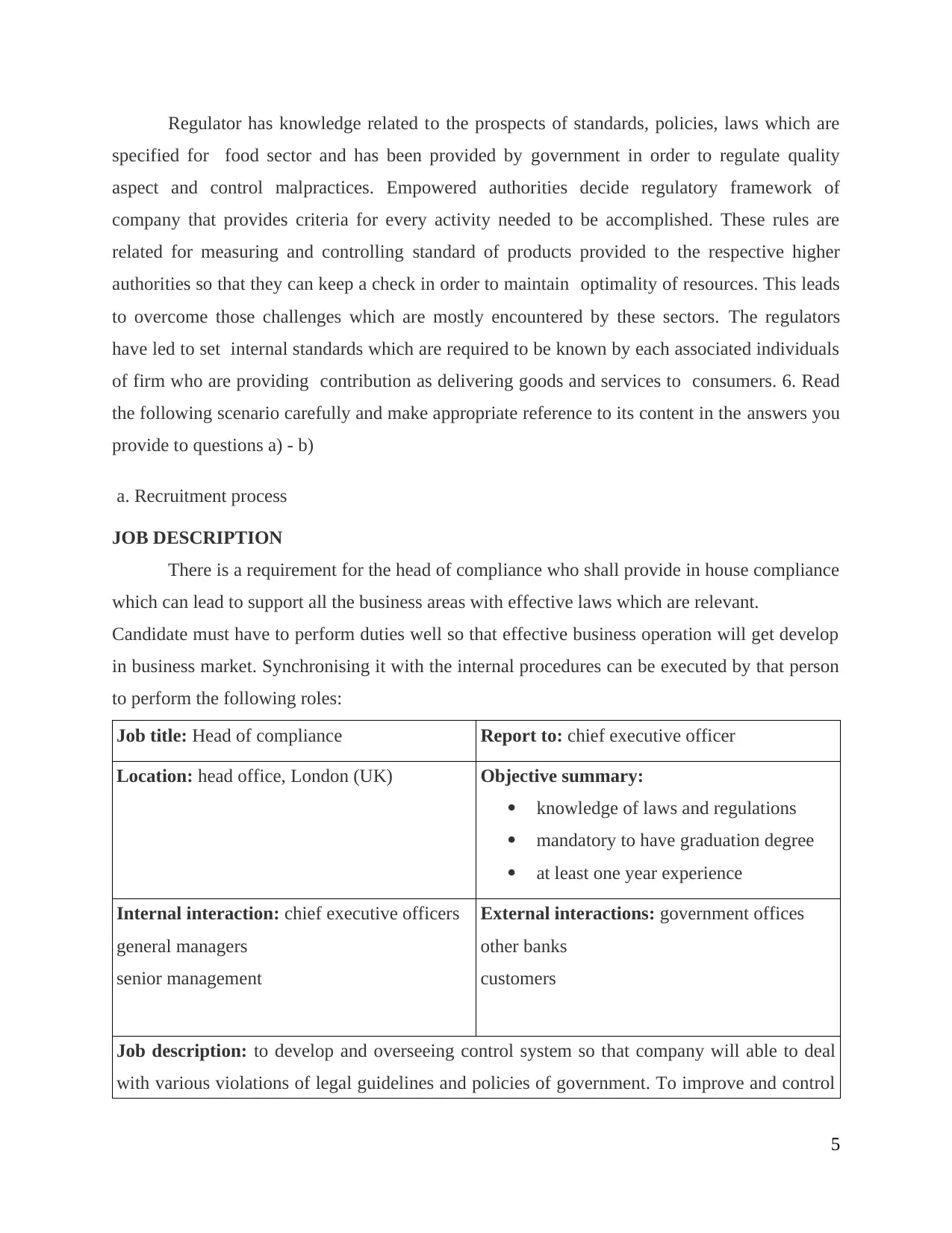
Regulator has knowledge related to the prospects of standards, policies, laws which are
specified for food sector and has been provided by government in order to regulate quality
aspect and control malpractices. Empowered authorities decide regulatory framework of
company that provides criteria for every activity needed to be accomplished. These rules are
related for measuring and controlling standard of products provided to the respective higher
authorities so that they can keep a check in order to maintain optimality of resources. This leads
to overcome those challenges which are mostly encountered by these sectors. The regulators
have led to set internal standards which are required to be known by each associated individuals
of firm who are providing contribution as delivering goods and services to consumers. 6. Read
the following scenario carefully and make appropriate reference to its content in the answers you
provide to questions a) - b)
a. Recruitment process
JOB DESCRIPTION
There is a requirement for the head of compliance who shall provide in house compliance
which can lead to support all the business areas with effective laws which are relevant.
Candidate must have to perform duties well so that effective business operation will get develop
in business market. Synchronising it with the internal procedures can be executed by that person
to perform the following roles:
Job title: Head of compliance Report to: chief executive officer
Location: head office, London (UK) Objective summary:
knowledge of laws and regulations
mandatory to have graduation degree
at least one year experience
Internal interaction: chief executive officers
general managers
senior management
External interactions: government offices
other banks
customers
Job description: to develop and overseeing control system so that company will able to deal
with various violations of legal guidelines and policies of government. To improve and control
5
specified for food sector and has been provided by government in order to regulate quality
aspect and control malpractices. Empowered authorities decide regulatory framework of
company that provides criteria for every activity needed to be accomplished. These rules are
related for measuring and controlling standard of products provided to the respective higher
authorities so that they can keep a check in order to maintain optimality of resources. This leads
to overcome those challenges which are mostly encountered by these sectors. The regulators
have led to set internal standards which are required to be known by each associated individuals
of firm who are providing contribution as delivering goods and services to consumers. 6. Read
the following scenario carefully and make appropriate reference to its content in the answers you
provide to questions a) - b)
a. Recruitment process
JOB DESCRIPTION
There is a requirement for the head of compliance who shall provide in house compliance
which can lead to support all the business areas with effective laws which are relevant.
Candidate must have to perform duties well so that effective business operation will get develop
in business market. Synchronising it with the internal procedures can be executed by that person
to perform the following roles:
Job title: Head of compliance Report to: chief executive officer
Location: head office, London (UK) Objective summary:
knowledge of laws and regulations
mandatory to have graduation degree
at least one year experience
Internal interaction: chief executive officers
general managers
senior management
External interactions: government offices
other banks
customers
Job description: to develop and overseeing control system so that company will able to deal
with various violations of legal guidelines and policies of government. To improve and control
5
Paraphrase This Document
Need a fresh take? Get an instant paraphrase of this document with our AI Paraphraser
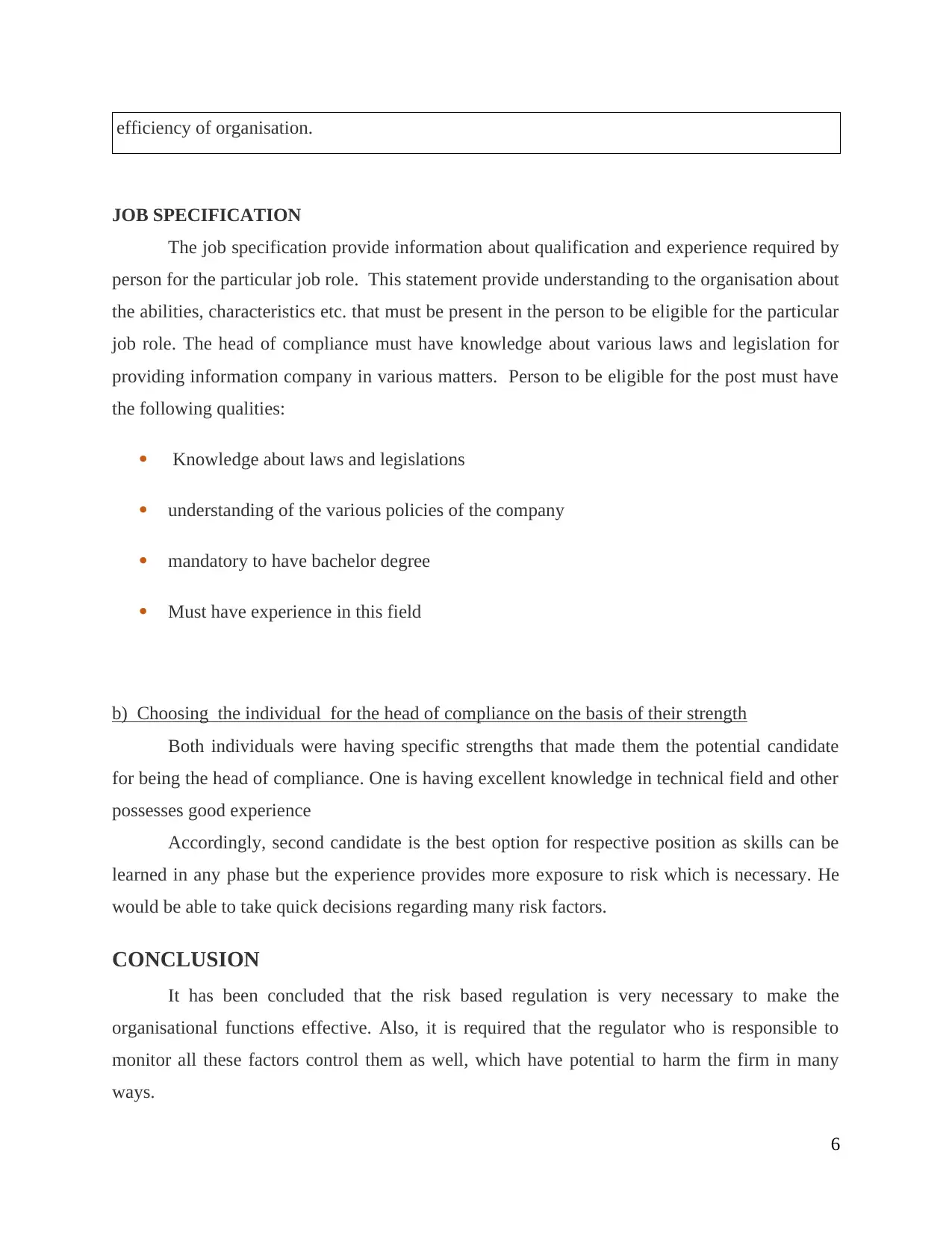
efficiency of organisation.
JOB SPECIFICATION
The job specification provide information about qualification and experience required by
person for the particular job role. This statement provide understanding to the organisation about
the abilities, characteristics etc. that must be present in the person to be eligible for the particular
job role. The head of compliance must have knowledge about various laws and legislation for
providing information company in various matters. Person to be eligible for the post must have
the following qualities:
Knowledge about laws and legislations
understanding of the various policies of the company
mandatory to have bachelor degree
Must have experience in this field
b) Choosing the individual for the head of compliance on the basis of their strength
Both individuals were having specific strengths that made them the potential candidate
for being the head of compliance. One is having excellent knowledge in technical field and other
possesses good experience
Accordingly, second candidate is the best option for respective position as skills can be
learned in any phase but the experience provides more exposure to risk which is necessary. He
would be able to take quick decisions regarding many risk factors.
CONCLUSION
It has been concluded that the risk based regulation is very necessary to make the
organisational functions effective. Also, it is required that the regulator who is responsible to
monitor all these factors control them as well, which have potential to harm the firm in many
ways.
6
JOB SPECIFICATION
The job specification provide information about qualification and experience required by
person for the particular job role. This statement provide understanding to the organisation about
the abilities, characteristics etc. that must be present in the person to be eligible for the particular
job role. The head of compliance must have knowledge about various laws and legislation for
providing information company in various matters. Person to be eligible for the post must have
the following qualities:
Knowledge about laws and legislations
understanding of the various policies of the company
mandatory to have bachelor degree
Must have experience in this field
b) Choosing the individual for the head of compliance on the basis of their strength
Both individuals were having specific strengths that made them the potential candidate
for being the head of compliance. One is having excellent knowledge in technical field and other
possesses good experience
Accordingly, second candidate is the best option for respective position as skills can be
learned in any phase but the experience provides more exposure to risk which is necessary. He
would be able to take quick decisions regarding many risk factors.
CONCLUSION
It has been concluded that the risk based regulation is very necessary to make the
organisational functions effective. Also, it is required that the regulator who is responsible to
monitor all these factors control them as well, which have potential to harm the firm in many
ways.
6
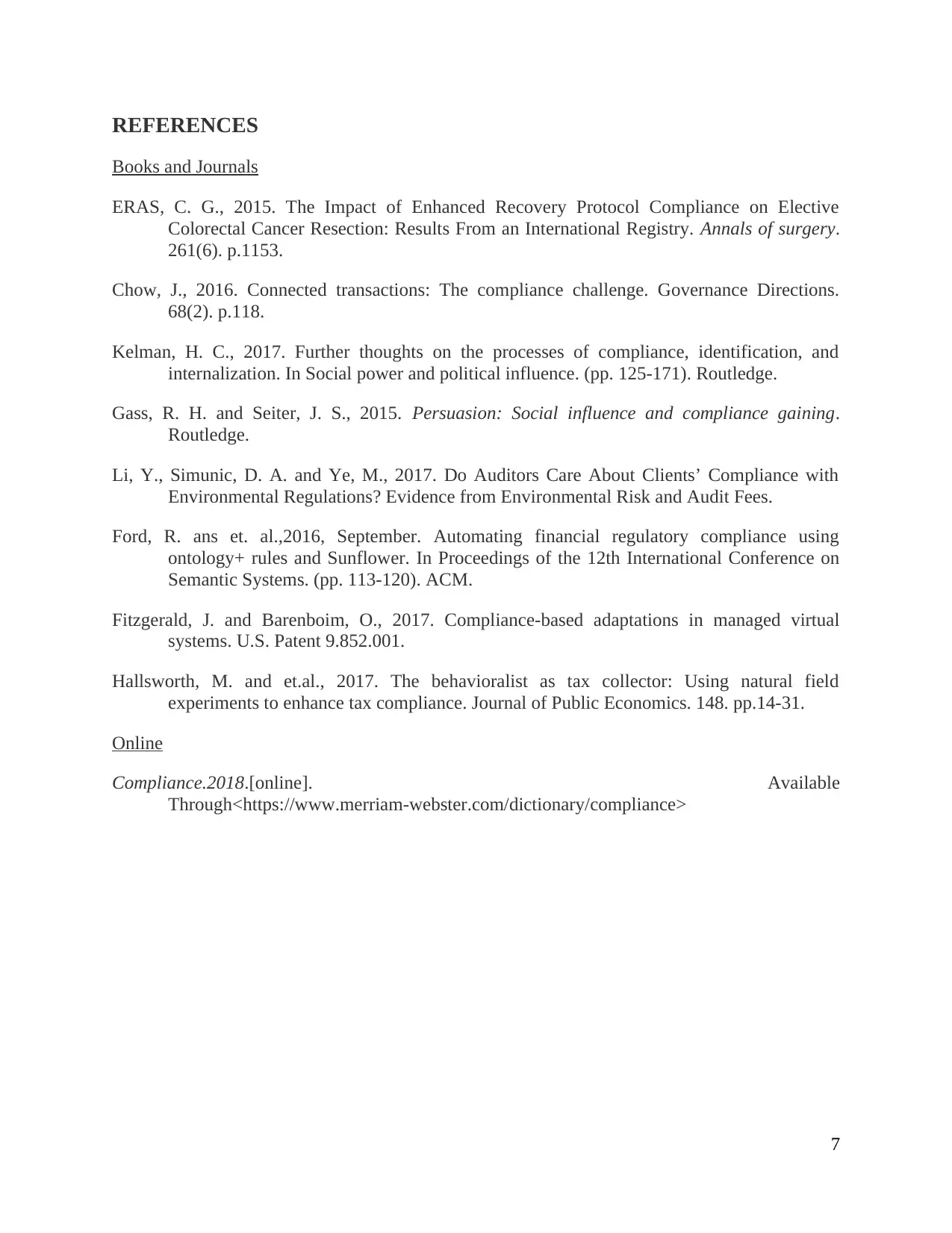
REFERENCES
Books and Journals
ERAS, C. G., 2015. The Impact of Enhanced Recovery Protocol Compliance on Elective
Colorectal Cancer Resection: Results From an International Registry. Annals of surgery.
261(6). p.1153.
Chow, J., 2016. Connected transactions: The compliance challenge. Governance Directions.
68(2). p.118.
Kelman, H. C., 2017. Further thoughts on the processes of compliance, identification, and
internalization. In Social power and political influence. (pp. 125-171). Routledge.
Gass, R. H. and Seiter, J. S., 2015. Persuasion: Social influence and compliance gaining.
Routledge.
Li, Y., Simunic, D. A. and Ye, M., 2017. Do Auditors Care About Clients’ Compliance with
Environmental Regulations? Evidence from Environmental Risk and Audit Fees.
Ford, R. ans et. al.,2016, September. Automating financial regulatory compliance using
ontology+ rules and Sunflower. In Proceedings of the 12th International Conference on
Semantic Systems. (pp. 113-120). ACM.
Fitzgerald, J. and Barenboim, O., 2017. Compliance-based adaptations in managed virtual
systems. U.S. Patent 9.852.001.
Hallsworth, M. and et.al., 2017. The behavioralist as tax collector: Using natural field
experiments to enhance tax compliance. Journal of Public Economics. 148. pp.14-31.
Online
Compliance.2018.[online]. Available
Through<https://www.merriam-webster.com/dictionary/compliance>
7
Books and Journals
ERAS, C. G., 2015. The Impact of Enhanced Recovery Protocol Compliance on Elective
Colorectal Cancer Resection: Results From an International Registry. Annals of surgery.
261(6). p.1153.
Chow, J., 2016. Connected transactions: The compliance challenge. Governance Directions.
68(2). p.118.
Kelman, H. C., 2017. Further thoughts on the processes of compliance, identification, and
internalization. In Social power and political influence. (pp. 125-171). Routledge.
Gass, R. H. and Seiter, J. S., 2015. Persuasion: Social influence and compliance gaining.
Routledge.
Li, Y., Simunic, D. A. and Ye, M., 2017. Do Auditors Care About Clients’ Compliance with
Environmental Regulations? Evidence from Environmental Risk and Audit Fees.
Ford, R. ans et. al.,2016, September. Automating financial regulatory compliance using
ontology+ rules and Sunflower. In Proceedings of the 12th International Conference on
Semantic Systems. (pp. 113-120). ACM.
Fitzgerald, J. and Barenboim, O., 2017. Compliance-based adaptations in managed virtual
systems. U.S. Patent 9.852.001.
Hallsworth, M. and et.al., 2017. The behavioralist as tax collector: Using natural field
experiments to enhance tax compliance. Journal of Public Economics. 148. pp.14-31.
Online
Compliance.2018.[online]. Available
Through<https://www.merriam-webster.com/dictionary/compliance>
7
⊘ This is a preview!⊘
Do you want full access?
Subscribe today to unlock all pages.

Trusted by 1+ million students worldwide
1 out of 9
Related Documents
Your All-in-One AI-Powered Toolkit for Academic Success.
+13062052269
info@desklib.com
Available 24*7 on WhatsApp / Email
![[object Object]](/_next/static/media/star-bottom.7253800d.svg)
Unlock your academic potential
Copyright © 2020–2025 A2Z Services. All Rights Reserved. Developed and managed by ZUCOL.





